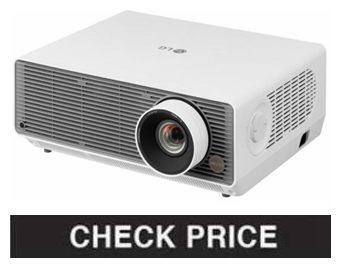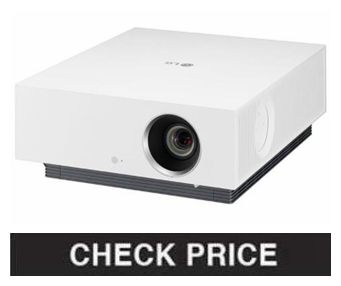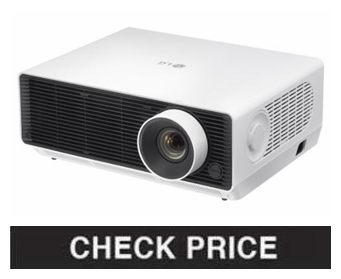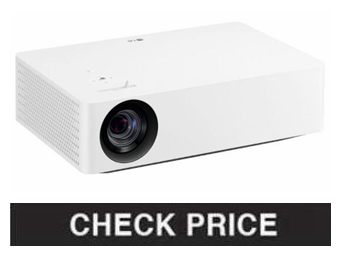
LG projectors are designed for portability and value, with LED lamps offering up to 30,000 hours of lamp life. LG projectors are ideal for gaming and home entertainment and to be moved from room to room as needed.
Contents
How Good Are LG Multimedia Projectors?
We have analysed 3,907 expert reviews and 21,227 user reviews for multimedia projectors and used this data to evaluate an average rating for LG multimedia projectors of 70%. This makes LG the 7th best projector brand according to customer reviews.
When Are Most New LG Multimedia Projectors Released?
January to February is the most common period for new LG multimedia projectors to be released in. If you want the latest LG data projector technology you may want to think about waiting until January 2022. It’s also worth keeping in mind that the price of the current LG multimedia projectors tend to drop off when the next models are released.
In January 2020, two new LG multimedia projectors were released making it the biggest month that year for new LG data projector releases. February was the biggest month in 2019 for new LG projectors, with two new LG projectors released that month. The biggest month in 2018 for new LG data projector releases was July, with 20 new LG data projectors released that month.
How Fast Do LG Projector Prices Drop After Release?
LG data projectors tend to depreciate faster than most data projectors. Most data projectors drop in price by 3% in the first 6 months after release. On average, in the first 6 months after release, LG multimedia projectors drop in price by 19%.
If you are prepared to wait then you could save an average of $267 on a typical $1,401 new LG projector by waiting 6 months before buying.
Best LG Projectors Reviews 2021:
1. LG CineBeam HU80KSW
One of the most feature-complete projectors you’ll ever find, the LG CineBeam is a really fascinating box of tricks. It may not be the finest on this list in terms of pure picture quality, but it presents a very decent 4K HDR image from a larger array of sources – both smart and local – than any other here. And for that, we commend it.
It’s blessed with LG’s excellent webOS platform, which means direct access to all your video apps over Wi-Fi, and its Miracasting and Bluetooth abilities make for easy and intuitive ad-hoc connections to whatever mobile device you’d like to play back from. These can provide external sound, too.
So is it expensive? Maybe. But for those who want the flexibility to throw a movie up on their wall whenever and however they choose, it’s just the ticket, with decent sound and a very solid picture as well. One of the best outdoor projectors you can buy.
- One-box, truly portable system
- Impressive 4K HDR picture
- Easy to build a system around
- Lacks a little detail
- Motion could be better
- Built-in speakers only adequate
2. LG ProBeam BU60PST
Inexpensive for its 4K product class and bright enough to fill a mid-sized conference room, church or classroom with video, the 6,000-lumen LG ProBeam BU60PST delivers a lot for a little. Surprisingly small, the projector has built-in Wi-Fi networking, a file viewer and a Web browser so that it doesn’t need a computer.
The LG ProBeam BU60PST sets a new standard for bringing 4K resolution to offices, schools and churches in a $4,999 projector that’s capable of delivering about 6,000 ANSI lumens. It not only hits a sweet spot on brightness and budget for these organizations, but the ProBeam BU60PST’s laser-based illumination engine also means that it will never need a lamp change, while the single-chip DLP imaging engine doesn’t need dust filter changes—making this as close to a zero-maintenance projector as exists today. That said, the big payoff is that it boasts Wi-Fi networking, a capable Web browser and a versatile file viewer that can project a variety of items from photos and .pdf files to Web sites and Google docs.
We applaud the ProBeam BU60PST’s innovative nub-based 4-way control panel that saves space and can be more efficient than a traditional 4-way button design, but the projector’s different interfaces can be confusing, to say the least. Plus, the ProBeam BU60PST does without some creature comforts, like a full manual to explain it all and a video-out port for an overflow room or secondary display in a lecture hall. Still, at its price the ProBeam BU60PST is about the least expensive and most feature-packed model in its brightness and resolution class, and takes a bold step into the future of projection for a church, classroom, retail location, business or government group. In other words, the ProBeam BU60PST creates a new category: the economical 4K business projector.
- Excellent value in its product class
- 3840×2160 4K UHD resolution
- Zero maintenance design
- Built-in Wi-Fi, file viewer and Web browser
- 1.6X zoom lens
- Multiple menu systems can be confusing
- Lacks video-out port
- No detailed manual
3. LG CineBeam HU810PW
With their attractive pricing and overall excellent performance, LG’s HU810PW and sister AU810PB could usher in the laser revolution for a legion of videophiles hungering to leave aging lamps behind.
The dropping cost of laser technology among commercial projectors in the last two years has relegated conventional lamp-based models to only the most cost-sensitive installations. Nonetheless, laser has seen a much slower uptake in the performance-sensitive home theater segment. While laser projectors have been an option among Sony’s top-of-the-line models for several years now (at prices starting well over $10,000), it wasn’t until the latest crop of UST living room projectors that we began to see laser applied in a meaningful way to consumer projectors at lower price points.
Now comes LG’s CineBeam AU810PB with an $3,999 list price, and its sister CineBeam HU810PW at an eyebrow-raising $2,999—LG’s first attempt at a serious, laser-driven, long-throw theater projector. At this writing, these are being promoted on the LG website at $3,599 and $2,699 respectively. The models should be identical in performance, but vary based on cosmetics, distribution channel, and inclusion of a few features.
- Long-life laser light source
- Accurate out-of-box color
- Effective dynamic HDR
- Sophisticated webOS smart platform
- HDMI 2.1 eARC port
- No 3D playback
- Netflix and some other key services not supported
- Middling input lag for gaming
- Limited low-level contrast
4. LG ProBeam BU50NST 4K Laser Projector
The LG ProBeam BU50NST’s 4K UHD resolution and 5,000-lumen rated brightness make it a strong contender for boardrooms, conference rooms, and other applications that need fine detail in a big image that can stand up to ambient light.
Most LG projectors to this point are meant for home or portable use. The 4K UHD (3840×2160), $4,499 LG ProBeam BU50NST laser projector is among the company’s first targeted for business and education. For the most part, it’s best described as the laser-based equivalent of a typical 5,000-lumen, lamp-based projector (which is how it is spec’d), and suitable for the same tasks.
Compared with most 5,000-lumen laser UHD projectors, the BU50NST is smaller, making it less obtrusive and easier to find room for. And although the documentation makes no mention of it, LG says the anti-dust optical engine and long-life laser light source make the projector virtually maintenance free. So while its natural home is a boardroom, large conference room or classroom, or small auditorium, the BU50NST is potentially useful also for applications like retail or museum displays and even sports bars.
- 4K UHD (3840×2160) resolution using XPR fast-shift pixel shifting; supports HDR 10
- Laser-phosphor light source promises up to a 20,000-hour lifetime
- 1.6x zoom lens; vertical and horizontal lens shift
- Lacks support for 360 degree orientation
- No 3D support
5. LG CineBeam PH30N Pico Projector
The LG CineBeam PH30N delivers somewhat mixed performance for image quality, but the balance of image quality, small size, and brightness is easily good enough for the price to let it serve nicely in a small conference room or for anyone who needs a light, bright projector they can take with them on the go.
The LG CineBeam PH30N is one of only a handful of projectors that share its particular mix of resolution, portability, brightness, and price. Just over a pound, it’s small and light enough so you can take it with you easily, and you can run it using AC power or its built-in battery. It’s also bright enough, with its 250-lumen rating, to give you a bigger image in ambient light than you can get from a phone, tablet, or laptop. And at $399.99 it’s eminently affordable.
LG rates the PH30N fan noise at up to 30 dB for full power, up to 28 dB for Medium, and up to 25 dB for Maximum Power Saving (Eco). At all three levels it’s the kind of steady sound that tends to fade into the background unless you’re particularly sensitive to fan noise. High Altitude mode, which LG recommends using at 4000 feet and above, is louder, but still quiet enough that most people shouldn’t find it bothersome.
- Delivers resolution equivalent to 720p on screen, using a 960×540 micromirror chip and XPR fast pixel shifting
- Accepts 1080p input
- Supports Bluetooth audio (in addition to having a 3.5mm audio out port) with Bluetooth AV sync adjustment
- Built-in rechargeable battery
- Some minor shifting of color bias based on content
- 1-watt mono speaker delivers low volume, making a headset or external sound system required in most circumstances
- No 3D support
6. LG CineBeam HU70LA
Best understood as a 4K UHD Smart TV that happens to use a projector for its display, the LG CineBeam HU70LA is targeted more at everyday consumers than traditional videophiles and dark-room home theater enthusiasts. The latter groups will find better overall picture quality with other products in this price class, but the HU70LA delivers a satisfying image for ambient light and lives up to its promise of behaving like a big screen Smart TV that’s also compact enough to be portable.
You can reasonably think of the $1,799 LG CineBeam HU70LA as a projector that includes a TV tuner, LG smart TV interface, LG ThinQ voice commands and Google Assistant. But that makes it sound like the TV and voice recognition features are some sort of clunky add-ons. Think of it instead as a 4K HDR smart TV that happens to use a projector as a display instead of a flat-panel, and you’ll have a much better sense of how well integrated TV and projector are and how it’s best used—namely, as a straightforward replacement for a big screen TV.
This isn’t to say that you can’t use the HU70LA like any other home theater projector. But the HU70LA is targeted more at everyday consumers than serious videophiles or home theater enthusiasts, and you’ll find projectors with overall better image quality for dark-room environments at around the same price.
What you’re paying for here, along with solidly competent LED-based projection, is LG’s sophisticated and proven web-streaming platform and user interface borrowed from its tradtional smart TVs. That, as well as the flexibilty that comes along with its compact, all-in-one package. For home use, for example, you can set it up as needed in any room or take it to the backyard for a movie night. LG also suggests it’s ideal for business use in small conference rooms, or as a light-weight 4K projector for road warriors.
- Long-life LED light engine
- Eight color presets for SDR; five for HDR
- Digital TV tuner and LG smart TV platform
- Google Assistant onboard
- Mediocre contrast/black level for dark-room viewing of 1080p content
- No HLG support
- No 3D support
Portability and Projection Tech
A home projector needn’t be a homebody. Many are portable enough to travel with, or at least to move easily from room to room. (The main exception is a home theater projector, which you’d most likely want to permanently install.) The gaming projectors we’ve seen are easy to bring along to a LAN party. Micro-projectors are highly portable, and come in both consumer and business models. (Many are good for both personal and business use.) This class of projector includes pico projectors, most of which can fit into a shirt pocket; palmtop models, which can fit in an outstretched hand; and some slightly larger models.
Most projectors are either LCD-based or use a Texas Instruments DLP (Digital Light Processing) chip along with a laser, LED, or LCOS (liquid crystal on silicon) light source.
Single-chip DLP projectors are potentially subject to what is known as the “rainbow effect.” Little red/green/blue, rainbow-like flashes may be visible, particularly in scenes with bright areas against a dark background. In some DLP projectors, the effect is minimal, but in projectors where the phenomenon is average to severe, people who are sensitive to these artifacts may find them distracting, particularly with video content. LCD projectors are immune to this effect, so they’re a safer bet if you or someone in your family is sensitive to the rainbow effect. That said, there are plenty of DLP projectors with excellent image quality.
FAQs
What is 4K resolution?
The resolution of a screen tells you just how dense are the tiny dots (aka the pixels) that collectively make up the image you see you. The higher the pixel count the higher the resolution. 4K resolution refers to a horizontal display resolution of approximately 4,000 pixels. With the “K” standing for “kilo” (thousand).
The majority of 4K displays come with a 3840 x 2160 pixel resolution. This is referred to as 4K UHD and is the 4k standard. You can also find 4K media that uses 4096 x 2160 in the movie projection industry. This is called DCI 4k.
How much is a 4K projector?
Most 4K projectors cost between $1,500 to $6,000. There are some higher end ultra high definition projectors that are priced at $9,000 and above. The variation in price is a result of a number of factors including throw distance, picture quality, bulb type, chipset and other features included with projector such as built in sound.





